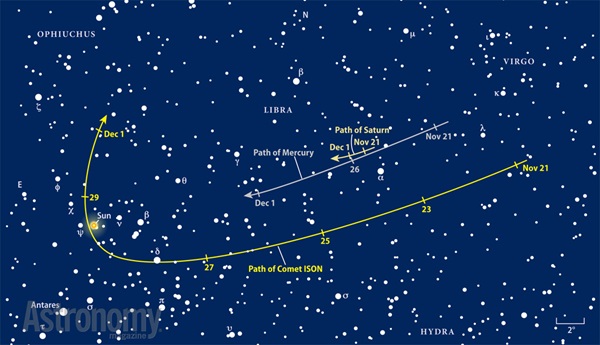Comet ISON (C/2012 S1) continues to brighten as it approaches the Sun. In the past week alone, it has experienced two distinct outbursts that saw its production of gas and dust increase by factors of 10 and six, respectively. This favorable trend should persist as ISON nears perihelion (its closest approach to the Sun) November 28. The Sun’s growing heat will warm the comet’s nucleus, causing the ices there to sublimate (turn directly from a solid to a gas) even more rapidly.
For complete coverage of Comet ISON, visit www.Astronomy.com/ISON.
In addition to ISON, the twilight sky also holds two bright planets. Mercury shines at magnitude –0.7 and stands 5° to the comet’s left. Saturn, at magnitude 0.6, appears 4° to Mercury’s lower left. Both planets will be easier to spot than ISON because they are brighter (barring another major comet outburst) and their light concentrates to a point. By the following morning (the 23rd), all three objects lie within 6° of one another and should show up in the field of view of 7×50 binoculars an hour before sunrise.
On November 25 and 26, Mercury lies within 1° of Saturn. The inner planet appears above the ringed world on the 25th; they switch positions the following day. The comet lies one binocular field below the planetary pair and will be difficult to see in the solar glare, even under nearly perfect conditions.
At perihelion November 28 (Thanksgiving Day in the United States), ISON sweeps within 1.16 million miles (1.86 million km) of our star’s center, or just 730,000 miles (1.16 million km) from its surface. The comet’s temperature should soar above 4500° Fahrenheit (2500° Celsius), providing lots of heat to sublimate ices. If predictions by the Minor Planet Center of the International Astronomical Union pan out, ISON will peak between magnitude –6 and –7, brighter than Venus. Although the comet then lies within 1° of the Sun, it might show up to amateur astronomers who carefully shield the Sun with a hand or a building.
But the best views of perihelion likely will come from a trio of solar telescopes located outside Earth’s atmosphere. The Solar Terrestrial Relations Observatory (STEREO), the Solar Dynamics Observatory (SDO), and the Solar and Heliospheric Observatory (SOHO) each supply different perspectives.
The most intriguing images likely will come from SOHO. On the evening of the 26th in North America, ISON enters the field of view of SOHO’s LASCO C3, a wide-field coronagraph that blocks the Sun’s disk and allows views of the solar corona and other nearby interesting things (such as comets). ISON remains in the C3 field for nearly four days. On the morning of November 28, the comet arrives in the narrower field of the LASCO C2 coronagraph and stays there for about 10 hours. You can access these images at sohowww.nascom.nasa.gov/data/realtime-images.html. Those from the C3 coronagraph are colored blue while ones from C2 are orange.
No one knows whether ISON will survive its rendezvous the Sun. Many astronomers think that it will stay intact and emerge on the other side glowing brightly before dawn, though a sizable minority think the close solar passage will cause the comet to break up. As long as ISON doesn’t disintegrate completely, however, it should put on a grand show in the morning sky during early December.













